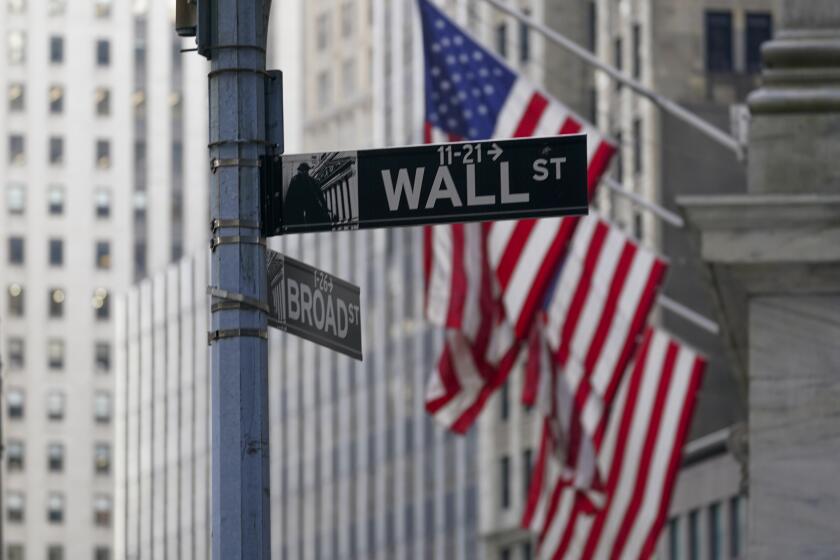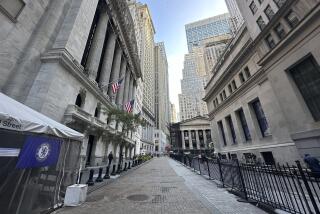Hoping to beat back inflation, Fed prepares to raise interest rates in March

- Share via
WASHINGTON — After downplaying the threat of inflation through most of last year, the Federal Reserve struck a more hawkish tone Wednesday as it signaled readiness to raise interest rates in March and take other aggressive actions to combat high prices endangering the nation’s economic health.
With decades-high inflation strapping workers and unsettling financial markets, Fed officials in recent days have been laying the groundwork for their first rate hike since slashing it to near zero as the pandemic was starting to intensify two years ago.
Investors and analysts are expecting at least two or three more quarter-point rate increases later this year. The Fed is also looking at tightening the country’s money supply further by shrinking its huge portfolio of government bonds and securities that the central bank purchased to lower long-term interest rates and stimulate economic activity.
As recently as last fall, Fed policymakers took a patient approach in withdrawing stimulus even as inflation was heating up, judging rising prices as a temporary consequence of supply chain problems and other factors related to the pandemic that would fade on their own.
But in a statement Wednesday issued at the conclusion of a two-day meeting and in remarks by Chair Jerome H. Powell afterward, the Fed made clear that it no longer held such a benign view of inflation and that its policy focus had pivoted from maximizing employment to its other chief goal: achieving price stability.
“Inflation risks are still to the upside,” Powell said during a news conference. “There’s a risk that the high inflation we’re seeing will be prolonged. There’s a risk that it will move even higher.... We have to be in a position with our monetary policy to address all of the plausible outcomes.”
Stocks sank as Powell answered reporters’ questions, with major indexes giving up gains earlier in the session in another volatile day on Wall Street. Both the Dow Jones industrial average and the broader Standard & Poor’s 500 dropped slightly, and were down 7.5% and 9.7%, respectively, from their highs in early January.
An early market rally gave way to a broad slide for stocks and a surge in bond yields Wednesday.
Powell said it was too early to talk about future interest rate increases, but at the Fed’s previous meeting in mid-December, most officials projected at least three quarter-point rate increases for this year. And since that meeting, Powell said Wednesday, the inflation picture has actually gotten a little worse. The consumer price index was up 7% in December from a year earlier — the highest in 40 years.
The Fed will issue new interest rate projections and an updated economic forecast at policymakers’ next meeting in mid-March.
Separately, the Fed on Wednesday issued a statement outlining general principles for “significantly reducing” the size of the Fed’s holdings of bonds and securities. Powell said officials haven’t made decisions on the timing or pace of the unwinding of its balance sheet, or the path of policy more generally, which remains largely dependent on what happens with the pandemic.
“We’ll be humble and nimble. We’re going to have to navigate crosscurrents and actually two-sided risks now,” Powell said.
The Fed is betting that it can get inflation under control, in part through its policy actions but also as the extraordinary pandemic fiscal support fades and supply chain bottlenecks improve. U.S. economic growth and the labor market have been strong, which Powell said gives the Fed space to raise rates without inflicting harm.
But economists worry that inflation may already be entrenched and that the Fed could step on the economic brakes too hard and send the country into recession. Doing too little, on the other hand, risks slow economic growth combined with high inflation, a condition known as stagflation, something the nation struggled with in the 1970s.
To avoid getting into such a tight spot, Fed officials historically have sought to take preemptive steps to curb inflation. In the 1950s, then-Fed Chair William McChesney Martin famously stated that the job of the central bank is to take away the punch bowl just as the party gets going.
“Well, the party is well underway,” said Phil Levy, chief economist at Flexport, a San Francisco freight shipment and customs brokerage company.
Levy sees the unusually high demand for goods, rather than transportation and other supply chain issues, as the underlying cause of rising inflation. And if the problem is one of an overheating economy, he and other analysts say, the Fed may have little choice but to apply tough medicine to slow demand.
“Odds of a policy misstep are uncomfortably high,” said Ryan Sweet, who follows the Fed at Moody’s Analytics.
High inflation and uncertainties about how the Fed will react have not only spread angst in financial markets but also cast a pall over many consumers and workers, many of whom saw strong wage gains last year, only to have them swamped by higher prices.
Moody’s Analytics has estimated that with prices rising at 7%, it was costing households on average $250 more a month than if the inflation rate was 2%, which is roughly where it was most of the last decade.
The current predicament means the central bank will have to make hard choices, including weighing the potential damage that higher rates may have on a still-healing labor market and stock markets that have enjoyed years of Fed support.
“The Fed’s biggest challenge is figuring out how to implement policy measures that are hawkish enough to lower inflation, but that also keep financial markets afloat, because volatility in financial markets may bleed into an economy that is already showing signs of slowing,” said Danielle DiMartino Booth, chief executive and chief strategist of Quill Intelligence, a research and consulting firm in Dallas. “The Fed is faced with choosing the lesser of two evils.”
More to Read
Get the L.A. Times Politics newsletter
Deeply reported insights into legislation, politics and policy from Sacramento, Washington and beyond. In your inbox three times per week.
You may occasionally receive promotional content from the Los Angeles Times.












